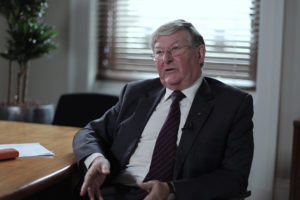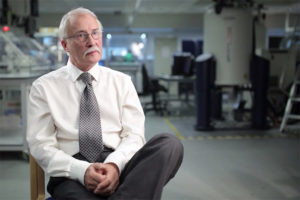Liquid metal mollusk that “eats” fuel ...
A first ever self-powered pump made of liquid metal was demonstrated, paving the way for making dynamically re...
How was the fullerene created? What does it look like? How can fullerenes be useful in practice? These and other questions are answered by Nobel Laureate Harold Kroto
That was around mid-70s to early 80s, very big discovers were made in carbon stars, particularly one that was quite close, red giant IRC +10216. This was a very intense infrared source. Radio astronomers then discovered that this carbon chains were coming of this star in very large amounts. In 1984 Robert Curl said that I should go and see Richard Smalley who developed some very interesting technology using laser to vaporize metals. I thought that instead of vaporizing metals, why not vaporize graphite and create the same conditions that one has in a red giant carbon star.
It was a very simple experiment, not even a very important one. But it became very important because it made this discovery. The carbon chains went on to assemble cage like molecules. The specific one that stuck out is a very intense signal of one of six carbon atoms, which had the same structure as a football with twelve pentagons and twenty hexagons. That was C60. Whilst we were trying to understand what was going on, and in fact, that was carried out with some fantastic young student, one thought that came in to my mind was that maybe the architectural structure by Buckminster Fuller, who had created geodesic domes and particularly one on the exposition Expo-67 in Canada, which I have a very striking image of, might have a clue.
My view is that the most important aspect of C60 and other fullerenes such as C70 is their powerful electron capture molecules. Therefore, I think that most important aspect will be the storage of electrons; this is thing, like battery technology and also solar energy conversion. There are some thoughts that there might be useful in medicinal chemistry. I think that it is possible in putting an atom on inside C60, because it is physically trapped rather than chemically trapped. If you look at the applications of safe radioactive atoms in radiotherapy, the one problem is that they are chemically toxic. The fullerene C60 should avoid that by putting a radioactive atom inside of this cage, so it is trapped and cannot get out. You can tag the outside to identify the area which is cancerous and the atom can get very close to the dangerous zone.
Source: PostNauka.ru

A first ever self-powered pump made of liquid metal was demonstrated, paving the way for making dynamically re...

Chemist David Phillips on the electron spin, singlet states and the singlet oxygen

Biochemist Ian Wilson on toxicity of paracetamol, clinical trials, and safe drugs